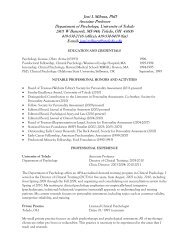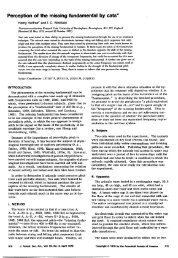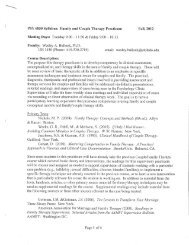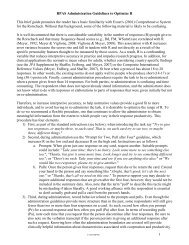The Rorschach Rating Scale: Item Adequacy, Scale ... - Psychology
The Rorschach Rating Scale: Item Adequacy, Scale ... - Psychology
The Rorschach Rating Scale: Item Adequacy, Scale ... - Psychology
- No tags were found...
Create successful ePaper yourself
Turn your PDF publications into a flip-book with our unique Google optimized e-Paper software.
228 MEYER, BATES, GACONOCamara, W., Nathan, J., & Puente, A. (1998). Psychological test usage in professional psychology: Reportto the APA Practice and Science Directorates. Washington, DC: American PsychologicalAssociation.Caspi, A., Block, J., Block, J. H., Klopp, B., Lynam, D., Moffitt, T. E., & Stouthamer-Loeber, M.(1992). A “common-language” version of the California Child Q-Set for personality assessment.Psychological Assessment, 4, 512–523.Clark, L. A., Livesley, W. J., Schroeder, M. L., & Irish, S. L. (1996). Convergence of two systems for assessingspecific traits of personality disorder. Psychological Assessment, 8, 294–303.Clark, L. A., Vorhies, L., & McEwen, J. L. (1994). Personality disorder symptomatology from thefive-factor model perspective. In P. T. Costa, Jr., & T. A. Widiger (Eds.), Personality disordersand the five-factor model of personality (pp. 95–116). Washington, DC: American PsychologicalAssociation.Cooper, S., Perry, J., & Arnow, D. (1988). An empirical approach to the study of defense mechanisms: 1.Reliability and preliminary validity of the <strong>Rorschach</strong> defense scale. Journal of Personality Assessment,52, 187–203.Costa, P. T., Jr., & McCrae, R. R. (1992a). Normal personality assessment in clinical practice: <strong>The</strong> NEOPersonality Inventory. Psychological Assessment, 4, 5–13.Costa, P. T., Jr., & McCrae, R. R. (1992b). Revised NEO Personality Inventory (NEO–PI–R) and NEOFive-Factor Inventory (NEO–FFI) professional manual. Odessa, FL: Psychological AssessmentResources.Costa, P. T., Jr., & McCrae, R. R. (1995). Solid ground in the wetlands of personality: A reply to Block.Psychological Bulletin, 117, 216–220.Exner, J. E., Jr. (1993). <strong>The</strong> <strong>Rorschach</strong>: A comprehensive system: Vol. 1. Basic Foundations (3rd ed.).New York: Wiley.Gabbard, G. O. (1990). Psychodynamic psychiatry in clinical practice. Washington, DC: AmericanPsychiatric Press.Gacono, C. B., & Meloy, J. R. (1994). <strong>The</strong> <strong>Rorschach</strong> assessment of aggressive and psychopathic personalities.Hillsdale, NJ: Lawrence Erlbaum Associates, Inc.Gacono, C. B., Meloy, J. R., & Berg, J. L. (1992). Object relations, defensive operations, and affectivestates in narcissistic, borderline, and antisocial personality disorder. Journal of Personality Assessment,59, 32–49.Glorfeld, L. W. (1995). An improvement on Horn’s parallel analysis methodology for selecting the correctnumber of factors to retain. Educational and Psychological Measurement, 55, 377–393.Goldberg, L. R. (1990). An alternative “description of personality”: <strong>The</strong> Big-Five factor structure. Journalof Personality and Social <strong>Psychology</strong>, 59, 1216–1229.Goldberg, L. R. (1992). <strong>The</strong> development of markers for the Big-Five factor structure. PsychologicalAssessment, 4, 26–42.Gorsuch, R. L. (1983). Factor analysis (2nd ed.). Hillsdale, NJ: Lawrence Erlbaum Associates, Inc.Gorsuch, R. L. (1997). Exploratory factor analysis: Its role in item analysis. Journal of Personality Assessment,68, 532–560.Guadagnoli, E., & Velicer, W. F. (1988). Relation of sample size to the stability of component patterns.Psychological Bulletin, 103, 265–275.Harkness, A., McNulty, J., & Ben-Porath, Y. (1995). <strong>The</strong> Personality Psychopathology Five (PSY–5):Constructs and MMPI–2 scales. Psychological Assessment, 7, 104–114.Kwawer, J. S. (1980). Primitive interpersonal modes, borderline phenomena, and <strong>Rorschach</strong> content. InJ. Kwawer, H. Lerner, & A. Sugarman (Eds.), Borderline phenomena and the <strong>Rorschach</strong> Test (pp.89–106). New York: International Universities Press.Lerner, H., & Lerner P. (1982). A comparative study of defensive structure in neurotic, borderline, andschizophrenic patients. Psychoanalysis and Contemporary Thought, 5, 77–113.Copyright © 2000 All Rights Reserved








